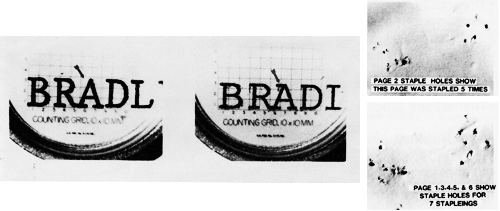By
George S. Pearl
There are approximately 400 questioned document
examiners and handwriting experts working in government or private practice
in the United States. Most of these examiners are employed by crime labs
in government agencies such as the FBI, Secret Service, IRS or Postal Service.
Though qualified examiners available for civil litigation are rather scarce,
they are available and may generally be found in metropolitan areas.
When an attorney needs a qualified questioned document examiner
and does not understand the field, he or she may be wrongly guided to a
graphologist or graphanalyst. A graphologist may be called a ”handwriting
expert,” but they are not allowed to testify as experts in the identification
of handwriting or other document problems in court. Graphologists sometimes
claim to do amazing things such as being able to describe one’s personality
or to diagnose medical problems through handwriting samples. These charlatans
have no place in our legal system and there is no valid proof of their claims
that is recognized in the scientific forensic community.
Questioned document examiners learn their profession in two
different ways: by being trained by the government or through their own
study and working with experts. The questioned document examiner is an expert
who can testify about the identity of a handwriting sample and about other
vital questions in litigation. Was the contract really prepared in June
of 1987? What was written under the Whiteout? Did the same typewriter prepare
all the documents? Who is sending all of these anonymous letters? Are these
medical records genuine2 These are but a few o f the questions the expert
can answer. Attorneys who discover fraudulent documents hold an advantage
over the opposite side. For a doctor caught in the altering of medical records
in a medical malpractice case, the settlement check is as good as signed.
When an examiner is utilized, the attorney should verify that
the examiner is certified through one or more professional organizations.
Examiners should have their own laboratory and scientific equipment for
the examination of documents. It is best to hire court-experienced examiners
who will be able to testify and demonstrate their findings in court.
As with most professions, there are many good practitioners,
but only a few are able to provide competent demonstrations to laypersons.
The result of a demonstration should be that an average person sees the
evidence presented and says, ”Hell, I can see that! What did we need
an expert for?” Sometimes showmanship is needed to keep people interested
and to help them better understand the demonstration.

These exhibits illustrate the minute details that distinguish one document another, sometimes identifiable only through the skills of a professional document examiner.
George Pearl, President of Atlanta based ALPS Evidence & Photo, is a certified evidence photographer and a fellow of the Evidence Photographers International Council and Certified Professional Photographer of the Professional Photographer of America. He is a Certified Questioned Document Examiner and Handwriting Expert with the Association of Forensic Document Examiners. He also serves as a board member of the Demonstrative Evidence Specialist Association dedicated to maintaining the highest standards in the production of demonstrative evidence.
* This article was first published in THE VERDICT of May / June of 1991.
© Atlanta Legal Photo Services, Inc.